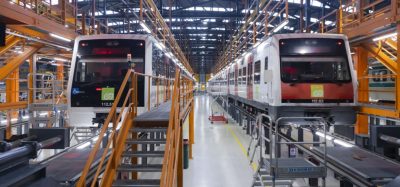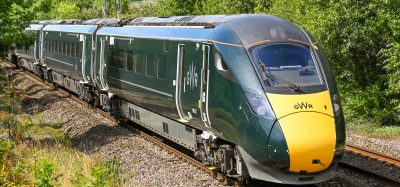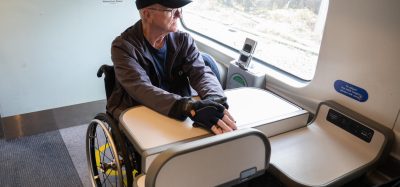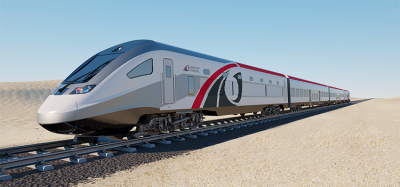Open to equality and accessibility
Posted: 8 April 2008 | | No comments yet
Our society has committed itself to provide equal access to the public transport system for all citizens. Despite common efforts to improve the accessibility of the rolling stock, there are still some deficiencies towards the Men Machine Interfaces (MMI’s) on mainline trains for physically and sensory impaired people.
Our society has committed itself to provide equal access to the public transport system for all citizens. Despite common efforts to improve the accessibility of the rolling stock, there are still some deficiencies towards the Men Machine Interfaces (MMI’s) on mainline trains for physically and sensory impaired people.
Our society has committed itself to provide equal access to the public transport system for all citizens. Despite common efforts to improve the accessibility of the rolling stock, there are still some deficiencies towards the Men Machine Interfaces (MMI’s) on mainline trains for physically and sensory impaired people.
Each new projected train is the subject of independent interpretation of the requirements proposed by national standards, the TSI (Technical Specification for Interoperability) and the UIC. The MODTRAIN project was started with the aim to modularise and standardise components of rolling stock. This goal should avoid new rolling stock development being built as a prototype from unproven sub-assemblies delivering shorter development and certification phases.
Five subprojects within MODTRAIN covered different areas and parts of a train, including:
- MODBOGIE
- MODCONTROL
- MODPOWER
- MODLINK
- MODUSER
All in all, 35 partners from the industry teamed up to develop solutions which will help reduce the costs for new interoperable equipment.
As a partner in the MODLINK subproject, the Human Factors Working Group at the TU Wien, together with IFE-Doors, the task to develop the guidelines for a modular and European-wide standardised portal door system.
Based on the experience of IFE and the Human Factors Working Group, the input from physically and sensory impaired people, the operators and a thorough analysis of European-wide and national standards, it was possible to identify the needs of all passengers towards the MMI´s of a portal door system.
Functional requirements
Defining the needed functions and the allocation of the functions was the first step of the scientific work load. It was agreed with the partners that the survey and further work should only deal with the following functions:
- Enable door opening
- Enable door closing
- Emergency egress device
- Emergency access device
- Lock out of service
Only the functions for the door opening/closing devices will be addressed in this article, as these functions were thoroughly tested by physically and sensory disabled persons, experts from the operators and disabled organisations during this project.
An investigation of existing door opening devices and emergency devices across Europe was carried out to gather the basic data for the next steps. Operating instructions were collected and reviewed, together with TSI, TSI-PRM, UIC standards and corresponding national documents.
The collection of data was completed from interviews with disabled people and the review of documents and standards regarding physically and sensory impaired people in the public.
The review of the gathered data quickly indicated that there are numerous different, partly opposing solutions and demands towards the door system MMI´s.
A function analysis of these MMI´s was performed to define the allocation of the function and the ergonomic concept. Based on this analysis, the solutions for the optical, acoustical and tactile information of the door opening/closing devices were developed. The signal definitions for the door MMI´s are based on the knowledge of the Human Factors Working Group and on already proven data.
- For the optimal usage by physical and sensory impaired people, the following states should be indicated in an acoustical, optical and tactile way:Deactivated/locked out of service/not released
- Released door/ready for input
- Acceptance of input
- Input not accepted
- Change of status (door opening/closing)
A new signal, suggested by people with impaired vision during the interviews, was an acoustical door and door opening device finding signal. With this sound signal, activated only on demand (to avoid any disturbance to other travellers), it will be possible for the users to easily and safely find the door.
To verify the gathered theoretical data, not only for the door operating devices, the partners of the project built a full-size mock-up of a mainline passenger train and several test rigs at Bombardier in Hennigsdorf. There, it was possible for the first time to test several different situations under ‘real life conditions’. For example, the scenario of boarding a train with a wheelchair with different door widths and ramp slopes. Next to the tests of the door activation devices, test rigs for different emergency modules and steps were also set up.
Evaluation
Thanks to the generous support of industry manufacturers Captron, EAO and Escha, it was possible to evaluate and compare the usability of different push buttons for physically and sensory impaired people for the first time. The tests made it possible to compare the above mentioned definitions for an optimised door opening device to the ones that are already in use today and to draw conclusions for further improvements.
Two panels with several different push buttons were used to evaluate the defined requirements and signals. With these two panels it was possible to compare the different solutions of push buttons with different feedback.
It was not possible to simulate all intended states at one button without signals from the door control to activate the state associated feedback. Therefore, it was necessary to have more than one of each of some push buttons.
Panel 1 (shown in Figure 1) was used to evaluate the general reactions of different user groups towards different door opening devices and their different feedback. For that purpose, three available push buttons from three different manufacturers were used. To test the reaction and necessity of the different kinds of feedbacks and pictograms, two buttons had all three signals (acoustical, tactile and optical). The other two had a combination of two of the possible kinds of feedback. Only one button (the first one from the right) was equipped with the door and door opening device finding signal.
The buttons on Panel 2 (showin in Figure 2) were used to establish if tactile feedback is needed and to test different mounting heights. Whereby button 1 (first from right) was used to test the need of tactile feedback. Button 2 and 3 (also viewed from the right) were used to evaluate sensing devices without any pedal travel. The furthest left button was a sensing device which provided vibrating feedback. The remaining two buttons were used to demonstrate (compared to the furthest right one) a different kind of tactile feedback.
On both panels, test persons were also asked for their opinion on the activation force for the different devices and their preference for the diameter of the activation field.
Next to the tests at the panel there was the possibility to evaluate one door opening device and the door finding signal at the portal door system of the train mock-up.
During three test sessions, 67 experts, physically and sensory impaired volunteers from six European countries evaluated the Industrial Design mock-up and the test rigs.
Passenger experience
Despite the small number of volunteers compared to the number of physically and sensory impaired people in Europe, it is still possible to perceive a trend from the results.
All volunteers commented that they appreciated the possibility to test the different push buttons and be involved in the mock-up in general, in a safe and controlled testing environment.
The same user group was also enthusiastic about the door and door opening finding signal. The device proved that it would really make their life easier when using public transport. To limit the disturbance to other passengers, the signal is supposed to be activated only on demand. Activation with a mobile phone or the white cane was suggested as a solution.
In general, they liked to have an acoustical signal for every state of the door system. Despite those finding, they were still concerned that the various and numerous demonstrated and intended acoustical signals may disturb other passengers, despite making travel easier for the disabled. This user group also complained about the protruding arrows on top of the activation field. Intended for easier recognition of the device, as demanded by many standards, by “feeling” the arrows, they stated, that the used arrows are too large to be palpable. They would prefer some smaller markings like dots. It is also important for them, that the door activation devices have round outlines which must protrude from the surrounding. All other kinds of outlines would not be associated with activation devices.
It was also stated that marking the activation device with Braille signs would only help a limited number of users. Firstly, not every blind person is able to ‘read’ them and secondly, it is not clear as to which generic language should be used for border crossing trains.
A conflict between the different user groups evolved about the question of the activation force and the necessity of pedal travel as tactile feedback. Visionary impaired users need the possibility to first recognise the intended function by touching them. Any activation only by nearing the activation device, as in the case of sensing devices, would put them in the danger of activating the door accidentally. In contrast, wheelchair users would prefer to only have sensing devices on trains. With limited arm reach, some buttons proved impossible for them to push correctly. In general, most users, except the wheelchair users, would prefer an activation device with pedal travel were they can feel the activation and an activation force of between 5 N and 10 N, never exceeding 10 N.
Consensus prevailed the question of the optimal size of the activation field. Most of the volunteers preferred a diameter between 40mm and 50mm which is in line with the definitions made beforehand.
Regarding the mounting height, the wheelchair users naturally demanded a much lower position (between 800mm and 850mm above floor level) than the rest of the test users. Interestingly, everybody else preferred more or less the same height, between 1,100mm and 1,200mm, as they wanted to see or feel the provided information. Blind users stated they want the buttons in such a distance from the ground, because for them it is easier to “look” for such devices with their fingers at that height. A possible solution would be to provide, at least at some special equipped doors, two door opening devices: one lower mounted sensing device and one mounted at higher place built with tactile feedback.
The tests in general confirmed the definitions of the analyses towards the optical, acoustical and tactile signals. It was confirmed by the volunteers, that at least two types of feedback should be provided for the optimal information of all user groups about the state of the door system. It would be even better to have all three types. To avoid any disturbance by the used acoustical signals the sound pressure level of the signal itself should be self adjustable to the noise pressure level of the surrounding area.
Way ahead
Despite being only a small part of the whole picture of the travel experience for physically and sensory impaired people, the identified improvements will certainly cost the operators of mainline trains more than the solutions used nowadays. Nevertheless, they will definitely, as confirmed by the tests, help to make travel easier for people with special needs.
About the authors
Walter Hackl-Gruber
During his 30 year career, both in Education and Research, in the field of ergonomics, Mr. Hackl-Gruber has obtained knowledge on many Human Factors related topics with specialisation on railway R&D. He also obtained specialist knowledge on men machine (computer)-interaction and as well as on occupational health and safety and industrial psychology. Beside his educational and R&D work, he is also Head of both the Austrian Ergonomics Association as well as the Austrian Ergonomics standards committee.
Matthias Barta
Mr. Matthias Barta joined the Human Factors Working Group at TU Wien in 2000 as an industry financed project engineer. During several national and international financed projects, he gained experience in the field of men machine interfaces, occupational health and safety, the measurement and evaluation of environmental influences on humans at workstations. The most notable projects he worked on have been the EC financed projects MODTRAIN and EUDDplus. Mr. Barta also represents TU Wien in the Rail Research Network of Excellence EURNEX.
Stay Connected with Global Railway Review — Subscribe for Free!
Get exclusive access to the latest rail industry insights from Global Railway Review — all tailored to your interests.
✅ Expert-Led Webinars – Gain insights from global industry leaders
✅ Weekly News & Reports – Rail project updates, thought leadership, and exclusive interviews
✅ Partner Innovations – Discover cutting-edge rail technologies
✅ Print/Digital Magazine – Enjoy two in-depth issues per year, packed with expert content
Choose the updates that matter most to you. Sign up now to stay informed, inspired, and connected — all for free!
Thank you for being part of our community. Let’s keep shaping the future of rail together!







